Peter DeMarco, Executive Vice President of Advocacy and Research – The IAPMO Group In 2019, the World Health Organization (WHO) started monitoring the outbreak of a new coronavirus which ultimately was named COVID-19. The virus was first identified in Wuhan, China. This paper is intended to provide practical guidance for plumbing professionals who work on Read more
Guest Blog
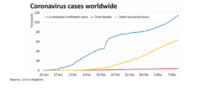
Peter DeMarco, Executive Vice President of Advocacy and Research – The IAPMO Group
In 2019, the World Health Organization (WHO) started monitoring the outbreak of a new coronavirus which ultimately was named COVID-19. The virus was first identified in Wuhan, China. This paper is intended to provide practical guidance for plumbing professionals who work on sanitary waste and sewer systems on how to protect themselves, their loved ones and their coworkers during the current pandemic.
Coronaviruses are so named because, when viewed under a microscope, they have protrusions that resemble a crown. They belong to a family of viruses common in both humans and many animal species. In rare occurrences, animal coronaviruses can mutate to the point where they are able to also infect humans, which is likely what occurred in China late last year. The potential for viruses that cross over from animals to humans to develop into an epidemic, happens when the virus can then be transmitted between humans. The COVID-19 virus is highly transmissible between humans and can cause respiratory illness and even death.
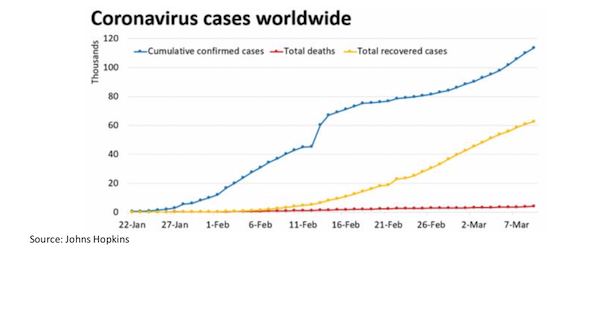
As of this writing on March 11, World Plumbing Day, the WHO has announced the outbreak qualifies as a pandemic, having spread on all inhabited continents. The worldwide number of humans diagnosed with COVID-19 has surpassed 120,000, with more than 4,300 deaths (see chart below). These numbers are predicted to grow. Unfortunately, there’s much we still don’t know about the virus, including important details about its transmissibility, how long it can survive on various surfaces or in water, and the range of illness severity amongst various population groups. It is known that the elderly and those who are immuno- compromised with pre-existing medical conditions are the most vulnerable for poor medical outcomes, which is consistent with other pathogen-based diseases, including influenza. However, contrary to some misinformation that’s currently available, the coronavirus is in fact considerably more dangerous than the current annual influenza virus.
So, what are the implications for those who work in the plumbing industry and what steps can plumbers take to stay safe? It is likely that the COVID-19 coronavirus can indeed be spread through building sanitary drainage systems. This became apparent when the Chinese government identified an outbreak in a Hong Kong high-rise building a few weeks ago (see the IAPMO white paper).
Therefore, for as long as the pandemic is still active, it should be assumed by anyone working on a sanitary drainage system that the virus is present. Considering the potential to come into contact with water and aerosols that contain the coronavirus when working on sanitary systems or sewers, it is highly recommended that plumbers wear proper personal protective equipment (PPE), including a full face shield that is worn over safety glasses, and gloves.
Of course, plumbers work on sanitary drainage systems that contain fecal matter and a host of dangerous pathogens every day. Taking careful precautions to prevent contact with wastewater and proper hand and arm hygiene is a matter of good practice for plumbers. In the United States, the Occupational Safety and Health Administration (OSHA) provides standards for worker protection. OSHA Standard 29 CFR 1926, Safety and Health Regulations for Construction provides the requirements for construction worker safety, including plumbers who work on sanitary drains, vent systems and sewers. The standards are available free at https://www.osha.gov/laws-regs/regulations/standardnumber/1926.
The most important subsections for plumbers to review are: 1926.20 – General safety and health provisions; 1926.21 – Safety training and education; 1926.22 – Recording and reporting of injuries; 1926.23 – First aid and medical attention; 1926.28 – Personal protective equipment; 1926.50 – Medical services and first aid; 1926.95 – Criteria for personal protective equipment; 1926.102 – Eye and face protection and 1926.103 – Respiratory protection.
Additionally, ASSE International’s Series 12000 Standard, Professional Qualifications Standard for Infection Control Risk Assessment for All Building Systems, is a standard that sets minimum criteria for the training and certification of pipe trades craftspeople, and other construction and maintenance personnel, on how to safely work in an environment with the potentially deadly diseases that may be present within
worksites. While the pandemic remains ongoing, ASSE International is making the ASSE Series 12000 Standard available for free at https://asse-plumbing.org/12000-2018 . The ASSE 12000 certification training addresses viruses, including the Sever Acute Respiratory Syndrome (SARS) virus, but does not specifically reference COVID-19. We welcome plumbers from across the globe to consider professional qualification for infection control risk assessment especially when working on sanitary systems that have a high probability of being contaminated with COVID-19, such as healthcare facilities and hospitals.
Finally, common sense still reigns supreme. Plumbers are advised to increase the frequency of hand washing and wash for at least 20 seconds with soap and water (even longer hand washing time is good practice after contact with wastewater); avoid touching of the face; cover any open cuts or wounds and wear proper PPE. If you personally come into close proximity, or into direct contact with an infected person, immediately report the incident to your supervisor and to your doctor or healthcare provider.
Good workplace and tool cleaning practices are also extremely important. Avoid sharing of tools with coworkers to the greatest extent possible. When choosing cleaning chemicals, look for cleaning agents with claims against viral pathogens. If such cleaning agents are not available, use soap and water and dry tools thoroughly after use. Keep your PPE clean as well by following manufacturer instructions carefully.
With no vaccine or treatment regimen currently available, it is important for all workers to be able to recognize the symptoms associated with contracting the coronavirus, which include fever, shortness of breath, and persistent cough. Symptoms can take between 2 to 14 days to become apparent after exposure to the virus. If you start to feel ill, stop work immediately so as to protect your coworkers and others around you, go home, contact your doctor and follow your doctor’s orders! This is critically important when working in a facility that houses immuno-compromised people.
The IAPMO Group sends its best wishes to plumbing professionals around the world. We hope that the information above is helpful. As usual, plumbers are on the front lines fighting the battles that keep people safe. By working carefully and thoughtfully, we can also keep ourselves and our loved ones safe as we deal with and defeat COVID-19!
Additional sources of useful information can be found at the links below:
https://www.who.int/emergencies/diseases/novel-coronavirus-2019
https://www.cdc.gov/coronavirus/2019-ncov/index.html
https://www.wef.org/resources/online- education/webcasts/ArchivedWebcasts/CoronavirusWebcastArchive/
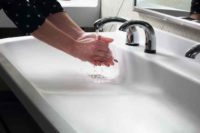
Menomonee Falls, Wis. — For the past 11 years, Bradley Corporation has conducted its Healthy Hand Washing Survey to track American’s hand washing habits and their reactions to germs, the flu and colds. The annual survey queried American adults and youth online Dec. 11-16, 2019. Participants were from around the country, were 14 years and older, and were Read more
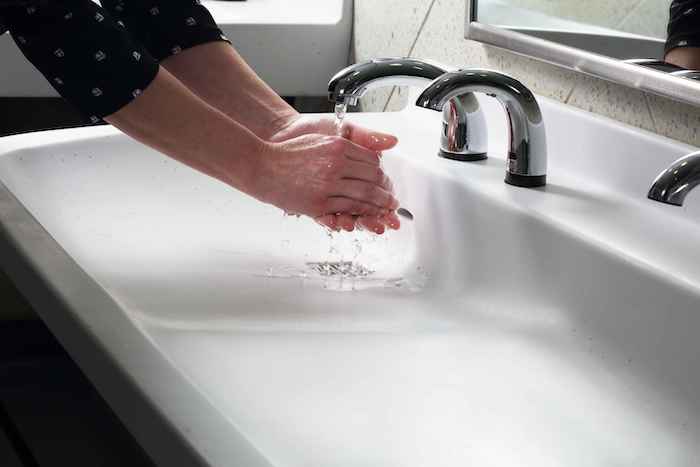
Menomonee Falls, Wis. — For the past 11 years, Bradley Corporation has conducted its Healthy Hand Washing Survey to track American’s hand washing habits and their reactions to germs, the flu and colds.
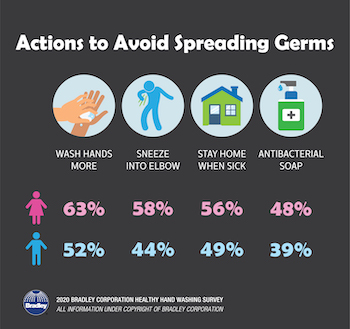
The annual survey queried American adults and youth online Dec. 11-16, 2019. Participants were from around the country, were 14 years and older, and were fairly evenly split between men and women (47% and 53%).
The findings revealed that:
- Even before COVID-19 hit the United States, 60% of Americans were extremely or quite concerned about catching the flu, compared to just 32% who felt that way four years ago. Among all age groups, Millennials expressed the most trepidation about getting sick.
- 50% of Americans said news coverage of cold and flu outbreaks has an impact on their hand washing behavior.
- In response to flu outbreaks, 79% of Americans said they wash their hands more frequently, more thoroughly or longer after using a public restroom.
- 89% of Americans in the workforce said they consciously take steps to avoid the germs of sick co-workers or colleagues.
- 64% of Americans correctly believe that hand washing is more effective in removing germs than hand sanitizer — a fact supported by the Centers for Disease Control and Prevention.
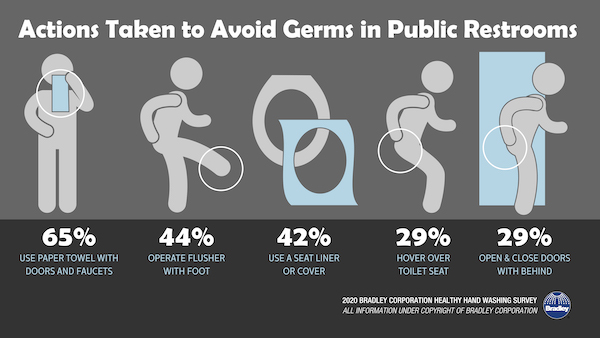
- When asked where they were MOST concerned about somebody not washing their hands, 40% said restaurants, 35% identified hospitals, clinics and doctors’ or dentists’ offices, 15% answered schools and 8% said airports.
- When they are sick, 54% of Americans said they simply wave hello to greet people, 48% avoid shaking hands and 18% use a fist or elbow bump.
- At home, if someone is sick or if a cold or flu virus is going around, Americans kick into action. 65% wipe down bathroom and kitchen surfaces. 47% wipe door knobs and handles. 46% wash sheets and/or towels.
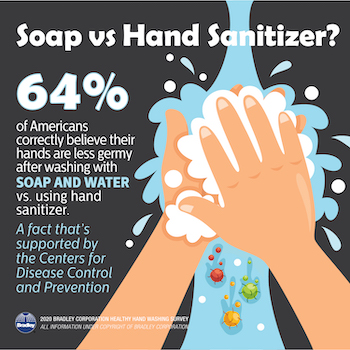
- In a public restroom, 93% of Americans try to avoid coming in contact with germs by employing evasive measures. 65% use a paper towel when touching door handles, faucets or toilet flushers, 44% operate the toilet flusher with their foot, 42% use a seat liner or cover, 29% hover above the toilet seat, 29% use their butt to open and close doors and 27% use their elbow to operate towel dispensers.
- 97% of Americans believe it’s important to wash up after using a public restroom. However, hand washing doesn’t happen all the time. Respondents said they washed their hands 86% of the time after using a public restroom.
- 67% of Americans admit they’ve skipped the soap and simply rinsed their hands with water after using a public restroom.
“Thorough hand washing with soap and water remains the best way to reduce the spread of disease-causing microorganisms like COVID-19,” says medical microbiologist Michael P. McCann, Ph.D., professor of biology, Saint Joseph’s University. “Soap and water, used as per the evidence-based recommendations of the Centers for Disease Control and other government agencies, will help reduce the spread of flu and other illnesses in the home and work place.”
Bradley Corp. is a leading manufacturer of commercial plumbing fixtures, washroom accessories, restroom partitions, emergency fixtures and solid plastic lockers.
For more information, visit www.bradleycorp.com/handwashing.
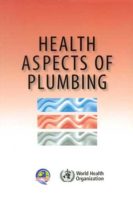
By Pete DeMarco, Executive Vice President of Advocacy and Research, IAPMO Health officials in Hong Kong have determined that plumbing systems in certain high-rise buildings are implicated in recent cases of the COVID-19 coronavirus. Based on the limited information available, it’s clear that transmission paths that would allow for the virus to spread between individual apartment Read more
By Pete DeMarco, Executive Vice President of Advocacy and Research, IAPMO
Health officials in Hong Kong have determined that plumbing systems in certain high-rise buildings are implicated in recent cases of the COVID-19 coronavirus. Based on the limited information available, it’s clear that transmission paths that would allow for the virus to spread between individual apartment units in at least one high-rise building have been identified. In order to understand how this has happened, it’s important to have some very basic knowledge of how wastewater systems work in high-rise buildings and to also look back at the SARS outbreak of 2003; the parallels are striking. In fact, the SARS virus is also a strain of coronavirus, so it’s not surprising that COVID-19 has been identified as having the potential to spread through plumbing systems.
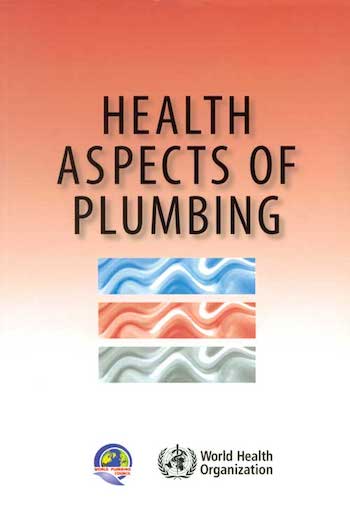 High-rise buildings present unique challenges in plumbing design. The following simplified explanation is intended to help illustrate the problem: When toilets in high-rise buildings are flushed, fecal matter and wastewater are discharged into a vertical wastewater pipe, called a “drainage stack.” As the wastewater descends in the stack, it creates pressure changes within the pipe. The wastewater flowing down a stack will push air down ahead of it and drag air behind it, creating both positive and negative pressures within the drainage system. These pressures can affect trap seals by either siphoning the water or pushing the water out of the trap. A second vertical pipe, called a “vent stack,” typically runs parallel to the drainage stack and introduces air into the drainage stack every fifth floor to avert excessive changes that could deplete trap seals and allow contaminated air and aerosols to enter apartments on other floors.
High-rise buildings present unique challenges in plumbing design. The following simplified explanation is intended to help illustrate the problem: When toilets in high-rise buildings are flushed, fecal matter and wastewater are discharged into a vertical wastewater pipe, called a “drainage stack.” As the wastewater descends in the stack, it creates pressure changes within the pipe. The wastewater flowing down a stack will push air down ahead of it and drag air behind it, creating both positive and negative pressures within the drainage system. These pressures can affect trap seals by either siphoning the water or pushing the water out of the trap. A second vertical pipe, called a “vent stack,” typically runs parallel to the drainage stack and introduces air into the drainage stack every fifth floor to avert excessive changes that could deplete trap seals and allow contaminated air and aerosols to enter apartments on other floors.
When the SARS outbreak occurred in 2003, problems with dry traps were indicated, allowing contaminated air and wastewater aerosols to enter into apartments on lower floors through floor drains that are required by Chinese and many other Asian national construction codes. A full explanation of how the SARS outbreak occurred and technical solutions providing health and safety associated with proper plumbing practices can be found in The Health Aspects of Plumbing, a publication produced by the World Health Organization and the World Plumbing Council.
Sadly, with the current coronavirus outbreak in Hong Kong, history seems to have repeated itself. According to the Associated Press, a 2016 Hong Kong Housing Department policy change has allowed tenants in certain high-rise apartments to alter the pipe design in their bathrooms without requiring an inspection by a plumbing official, causing the problem that might have helped spread COVID-19. In one of the apartment units, the vent pipe was completely disconnected inside the bathroom, apparently by the occupant, which provided a pathway for contaminated air to enter the apartment, especially when the bathroom ceiling fans were activated. When health officials became aware of this problem, the building was evacuated, hopefully limiting the number of additional illnesses among building residents.
Can the COVID-19 coronavirus be spread in high-rise buildings in the United States in a similar manner? In short, the answer is yes, but unlikely. Due to U.S. plumbing codes, any modification to a building’s water, waste or vent system must be performed by a qualified professional and necessitates an inspection by a code official. In addition, wastewater stacks and vent pipes are typically hidden behind walls in high-rise buildings, reducing the opportunity for residents to easily cut into pipes and create unsafe conditions.
Both the SARS and the current COVID-19 coronavirus outbreaks in Hong Kong illustrate the importance of proper plumbing design and practice in keeping building residents safe from disease and the profound problems that can develop when unqualified individuals decide to work on building water systems. The axiom “the Plumber Protects the Health of the Nation” is more than a slogan. Improper deviations to building plumbing systems can, and indeed often do, result in very significant loss of life and property.
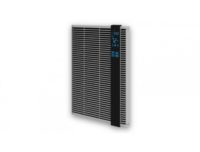
Blustery days with chilling winds can cause heating problems in many facilities with high volumes of foot traffic. While the main rooms within the building may be warm from the primary heating source, many areas are left out in the cold as drafts bring the temperatures down. Vestibules, lobbies, entrance ways and hallways can all Read more
Blustery days with chilling winds can cause heating problems in many facilities with high volumes of foot traffic. While the main rooms within the building may be warm from the primary heating source, many areas are left out in the cold as drafts bring the temperatures down. Vestibules, lobbies, entrance ways and hallways can all see a steady flow of people moving in and out throughout the day, opening doors and letting in chilly air.
To counteract these cold drafts, facilities should consider fan-forced wall heaters that provide continuous comfort through optimized airflow. Gentle heating sources are often not powerful enough to provide sufficient warmth in drafty areas. Fan-forced wall heaters however, push back on the infiltrating cold air, ensuring occupants feel the warmth as soon as they enter the building and until the moment they leave.
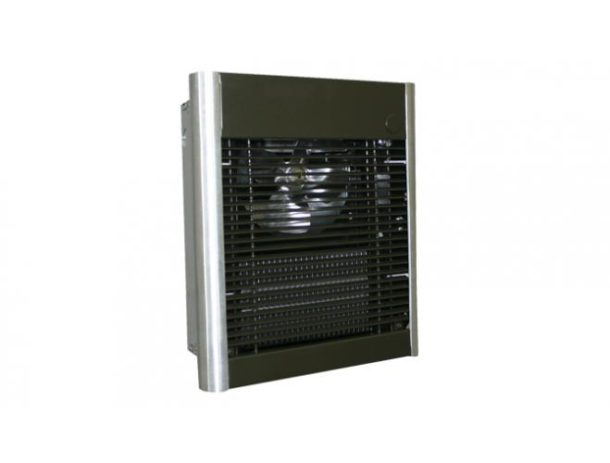
Functionality is Key
Cold air manages to find its way into facilities by any means necessary – whether it’s through vents, cracks, crevices or unsealed windows. Specialized heating units can stop these drafts before they spread throughout a building, bringing down temperatures and reducing overall heating efficiency.
Fan-forced wall heaters with an automatic delay eliminate cold drafts on start-up and discharge residual heat from the heater body during shut down. This helps attack drafts at their source while making the best use of available heat. In addition, consider fan-forced wall heaters that come with an integrated thermostat allowing for easy adjustment of room temperature to maintain a desired comfort level.
Perhaps a lobby is experiencing high foot traffic at the beginning and at the end of the workday, but have less heating requirements in the middle of the day. The adjustable thermostat allows occupants to alter the wall heater’s output based on need, ensuring no heat is wasted and temperatures remain comfortable. QMark and Berko’s commercial fan-forced wall heaters offer contemporary styles to match any room décor while ensuring adjustable warmth throughout the year.
Safety First
As with any heating unit, it is imperative to select high-quality products that offer protection against common safety risks. In terms of general design, fan-forced wall heaters come with a clear, easily accessible power on/off switch for added safety during maintenance, as well as a tamper-proof plug for the thermostat hole.
Also, look for fan-forced units with a manual reset thermal overheat protector that disconnects the power in the event of accidental blockage. This will ensure a quick repair while mitigating risk of injury. Furthermore, units that include permanently lubricated fan motors report increased longevity and lower maintenance needs, while gently distributing warmth throughout a designated area. Make sure the fan is powerful enough to offset drafts while quiet enough to eliminate unnecessary noises that may disrupt daily activities.
Key Takeaways
Every time a door opens during the cooler months, drafts blow in and bring a chilling effect into heated spaces. To neutralize the draft threats, consider installing a fan-forced wall heater to regain warmth and ensure comfortability for all occupants. Commercial fan-forced wall heaters from Berko and QMark provide strong yet safe sources of heat for the draftiest of spaces.
About the author: Andrew Martin is a product manager at Marley Engineered Products®, a leading North American designer and manufacturer of reliable comfort heating and ventilation solutions for residential, commercial and institutional buildings. Recognized by contractors, architects, engineers and HVAC professionals for providing a wide range of high-performance, reliable heating and ventilation solutions, Marley Engineered Products’ brands include QMark®, Berko®, Fahrenheat® and Leading Edge®.
Marley Engineered Products’ manufacturing operations are based in Bennettsville, S.C., with regional sales representatives located throughout the U.S. and an administrative office in Burr Ridge, Ill. For more information, please visit www.marleymep.com.
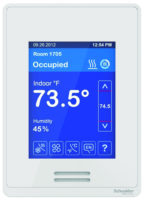
Connected technology is permeating every aspect of our lives from the homes we live in, to the cars we drive and now, even the cities where we work. As smart cities gain popularity, smart buildings can act as the building blocks of a city’s infrastructure, but facility managers and building owners must get onboard with Read more
Connected technology is permeating every aspect of our lives from the homes we live in, to the cars we drive and now, even the cities where we work. As smart cities gain popularity, smart buildings can act as the building blocks of a city’s infrastructure, but facility managers and building owners must get onboard with – and trained on – smart technology first.
In commercial buildings, one way connected environments can be created is through heating and air conditioning systems that respond to both occupancy and room conditions. This level of automation not only makes it easier for facility managers to operate buildings and keep spaces comfortable, but it also helps save on energy costs and reduces environmental impact, without compromising comfort or safety.
Creating a Customizable, Independently Operated Environment
As many commercial buildings have a multitude of different spaces to tend to, using smart, connected technology to cater to the heating and cooling needs of each space is key to ensuring a simplified building management process as well as occupant comfort.
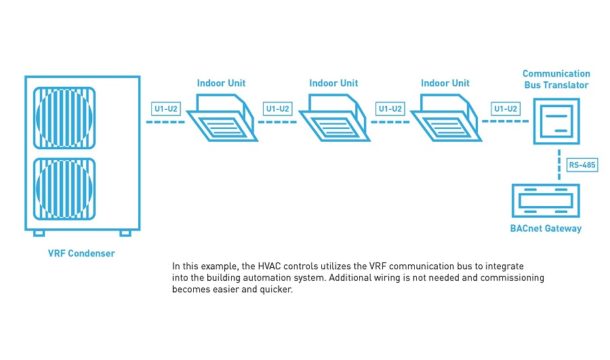
Variable Refrigerant Flow (VRF) technology paired with smart connectivity controls dynamically offers not only temperature controllability but also cost savings, allowing facilities to manage equipment, lighting, security and electricity remotely from a single interface. With the ability to connect the system to optional door, ceiling, window and carbon dioxide sensors, a building can truly become “smart,” so that the heating and cooling technology automatically adjusts based on in-room conditions.
In a hospitality setting such as a hotel, this can be paramount to securing return visitors. By deploying in-room controls with customizable interfaces within each individual room, the hotel can begin to position itself as at the forefront of a smart hotel experience. With controls capable of custom welcome messages to guests and providing real-time updates on in-room conditions, guests will feel like they’re in a modern, personalized environment.
Similarly, an office environment can benefit from connected HVAC technology. If you’ve ever worked in an office that blasts air conditioning or neglects to use it, you know that temperature can directly impact employee productivity. With connected HVAC technology, workers can feel comfortable, reducing opportunities for distraction and keeping them focused on the task at hand.
Using HVAC Technology to Reduce Environmental Impact
According to the General Services Administration, VRF technology can save users up to 30% on HVAC energy costs, ultimately as a result of their smaller design, which uses less material than older, traditional HVAC equipment. Because these systems also use advanced technology to control temperature, they are more accurate and have a decreased margin of error, extending the lifecycle of the system and reducing the likelihood of maintenance or repair.

With cities consuming nearly 80% of energy production worldwide and an equal share of global greenhouse gas emissions, it is time for change – for the planet and for the bottom line. Smart cities, with tech-savvy smart buildings communicating through the Internet of Things and running on energy efficient technologies, can make a significant impact on global emissions and the lifespan and health of our planet. For business owners, technologies like VRF, among others, can reduce energy waste and in turn, energy costs, while improving tenant productivity and overall indoor comfort.
Propelling the HVAC Industry Forward
The answer is clear: It’s time for building owners, facility maintenance professionals and installation professionals to work together to maximize the value of smart buildings and cutting-edge heating and cooling technologies. As smart technology continues to change the way we live and work, the HVAC industry is in a perfect position to grow, and smart buildings equipped with connected HVAC technology are just another step towards a world full of more productive – and comfortable – cities and citizens.
 Malcolm Persaud is the National Sales and Product Manager – Commercial VRF for Panasonic’s Heating and Air Conditioning Group. Malcolm Persaud has a wealth of technical and sales leadership experience through the years with Sanyo and Panasonic. He was instrumental in Sanyo’s VRF successful sales launch and growth in the US market starting in 2005.
Malcolm Persaud is the National Sales and Product Manager – Commercial VRF for Panasonic’s Heating and Air Conditioning Group. Malcolm Persaud has a wealth of technical and sales leadership experience through the years with Sanyo and Panasonic. He was instrumental in Sanyo’s VRF successful sales launch and growth in the US market starting in 2005.
